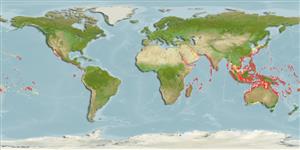Environment: milieu / climate zone / depth range / distribution range
Ecologia
marinhas; estuarina associadas(os) a recifes; não migratória; intervalo de profundidade 1 - 50 m (Ref. 90102). Tropical; 25°C - ?; 36°N - 36°S, 24°E - 77°W
Indo-Pacific : Red Sea and East Africa (Ref. 4919) to Panama, north to southern Japan and the Hawaiian Islands, south to Lord Howe and Rapa islands. Eastern Pacific: Baja California and the Gulf of California to Panama (Ref. 9349, 11482).
Tamanho / Peso / Idade
Maturity: Lm ? range ? - ? cm
Max length : 50.0 cm TL macho/indeterminado; (Ref. 30874); peso máx. publicado: 2.0 kg (Ref. 40637)
Espinhos dorsais (total) : 0; Raios dorsais (total) : 10 - 11; Espinhos anais: 0; Raios anais : 10 - 11. This species is characterized by the following: The body is generally greenish-brown in color, the back, sides and caudal fin profusely speckled with white spots, and the belly marked with white bars. A single bent lateral line. Body with small spines except around snout and caudal peduncle. Each nostril with two fleshy solid tentacles. Restricted gill opening.
Inhabit outer reef slopes to depths of at least 50 m, inner reef flats and lagoons. Juveniles common in weedy areas of estuaries (Ref. 4919). Also found in coastal bays and estuaries, usually near rocky reef or on sand-stretches between reefs with low algae-rubble reef to about 20 meters depth, or in shallow with sparse seagrass growth (Ref. 48637). Benthopelagic (Ref. 58302). Usually solitary and territorial on sandy to rubble areas. Feed on fleshy, calcareous, or coralline algae, detritus, mollusks, tunicates, sponges, corals, zoanthid anemones, crabs, tube worms and echinoderms (Ref. 1602).
Ciclo de vida ou comportamento de acasalamento
Maturidade | Reprodução | Desova | Ovos | Fecundidade | Larvas
Myers, R.F., 1991. Micronesian reef fishes. Second Ed. Coral Graphics, Barrigada, Guam. 298 p. (Ref. 1602)
Status na Lista Vermelha da UICN (Ref. 130435: Version 2024-1)
Ameaça para os humanos
Poisonous to eat (Ref. 4690)
Uso pelos humanos
Pescarias: pouco comercial; peixe esportivo: sim; Aquário: Espécies comerciais
Ferramentas
Relatórios especiais
Baixar XML
Fontes da internet
Estimates based on models
Preferred temperature (Ref.
123201): 23.7 - 29, mean 27.7 °C (based on 1504 cells).
Índice de diversidade filogenética (Ref.
82804): PD
50 = 0.5000 [Uniqueness, from 0.5 = low to 2.0 = high].
Bayesian length-weight: a=0.03981 (0.02445 - 0.06482), b=2.82 (2.69 - 2.95), in cm total length, based on LWR estimates for this species & Genus-body shape (Ref.
93245).
Nível Trófico (Ref.
69278): 3.2 ±0.0 se; based on diet studies.
Resiliência (Ref.
120179): médio(a), tempo mínimo de duplicação da população 1,4 - 4,4 anos (Preliminary K or Fecundity.).
Fishing Vulnerability (Ref.
59153): Moderate vulnerability (40 of 100).
Nutrients (Ref.
124155): Calcium = 33.9 [14.1, 86.4] mg/100g; Iron = 0.555 [0.297, 1.204] mg/100g; Protein = 18.6 [16.4, 20.7] %; Omega3 = 0.113 [0.059, 0.212] g/100g; Selenium = 37.1 [18.8, 80.3] μg/100g; VitaminA = 38.4 [10.4, 141.7] μg/100g; Zinc = 1.13 [0.76, 1.70] mg/100g (wet weight); based on
nutrient studies.
